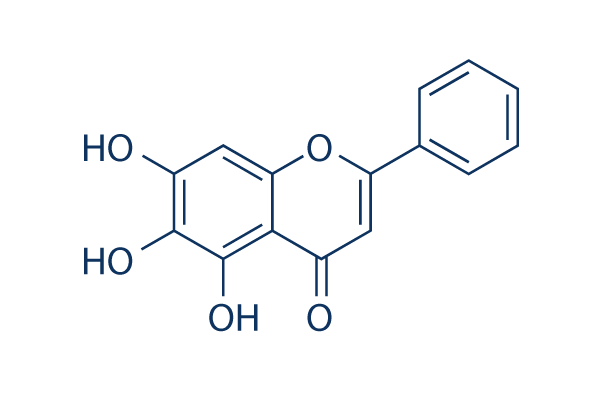All AbMole products are for research use only, cannot be used for human consumption.

In vitro: Baicalein suppresses mitogen induced T cell proliferation and cytokine secretion in vitro. Pre-treatment with baicalein significantly suppresses Con A or anti-CD3/CD28 mAb induced proliferation as well as cytokine secretion at 25 μM. Baicalein treatment induces DNA binding of NF-κB but inhibits thioredoxin activity in the nuclear compartment. Baicalein suppresses proliferation, migration, and invasion of MDA-MB-231 cells in a time- and dose-dependent manner. Baicalein significantly decreases the expression of SATB1 in MDA-MB-231 cells. Baicalein also downregulates the expression of Wnt1 and β-catenin proteins and transcription level of Wnt/β-catenin-targeted genes. In vivo: Baicalein suppresses induction of graft versus host disease but does not inhibit homeostatic proliferation of T-cells in mice. This observation clearly shows potent anti-inflammatory activity of baicalein in vivo. Rats treated with baicalein are protected against an increase in heart to body weight ratio, plasma level of brain natriuretic peptides, intraventricular septum thickness, myocardial collagen volume of left ventricle (all P<0.05, respectively). The antifibrotic effects of baicalein are further illustrated by the suppressed expression of left ventricle pro-collagens I and III accompanied by the decreased expression of 12-lipoxygenase, and by reduced expression and activity of matrix metallopeptidase 9 and extracellular signal-regulated kinases. Baicalein can inhibit cardiac fibrosis in hypertensive rats.

Phytomedicine. 2024 Feb 16.
Baicalein improves the symptoms of polycystic ovary syndrome by mitigating oxidative stress and ferroptosis in the ovary and gravid placenta
Baicalein purchased from AbMole

Trop J Pharm Res. 2020 Nov;Vol. 19 No. 7.
Baicalein inhibits cell development in papillary thyroid cancer by regulating miR-206/RAP1B pathway
Baicalein purchased from AbMole
| Cell Experiment | |
|---|---|
| Cell lines | MDA-MB-231 cells |
| Preparation method | MDA-MB-231 cells are routinely digested, collected, and then seeded in 96-well plates at a density of 8×10^3 cells/well. After incubation for 12-24 hours, cells are treated with 0, 20, 40, 60, 80, 100, and 120 μM baicalein according to their experimental grouping and then incubated at 37°C for 24, 48, and 72 hours |
| Concentrations | 0, 20, 40, 60, 80, 100, and 120 μM |
| Incubation time | 12-24 h |
| Animal Experiment | |
|---|---|
| Animal models | Female (age 6–8 weeks) athymic nude mice |
| Formulation | dissolved in 10% DMSO and 90% sesame oil to form an emulsion |
| Dosages | 25 mg/kg |
| Administration | i.p. |
| Molecular Weight | 270.24 |
| Formula | C15H10O5 |
| CAS Number | 491-67-8 |
| Solubility (25°C) | 54 mg/mL in DMSO |
| Storage | 2-8°C, protect from light |
| Related Products |
|---|
| 7-Deoxyloganin
7-Deoxyloganin is a biosynthetic precursor of Loganin. 7-Deoxyloganin undergoes hydroxylation catalyzed by 7-deoxyloganin 7-hydroxylase, a cytochrome P450-dependent monooxygenase, to produce Loganin. |
| Mannose-BSA
Mannose-BSA is an important organic intermediate that combines the properties of mannose and bovine serum albumin, which is of unique value in the field of scientific research, and can be used as a key substance in a variety of organic synthesis reactions. Mannose is an important monosaccharide that binds specifically to mannose receptors (e.g., CD206 receptors on dendritic cells and macrophages), and therefore has a wide range of applications in immunomodulation and targeted drug delivery. BSA is a protein carrier that is commonly used for biocoupling, and its abundant surface amino groups can covalently bind to mannose to form a mannose-BSA complex. |
| Sulfo-NHS-Biotin
Sulfo-NHS-Biotin stongly label single SDS-2ME soluble cuticular protein. |
| GAPDH-IN-1
GAPDH-IN-1 (GAPDH Inhibitor Compound F8) is a covalent inhibitor of GAPDH (IC50 = 39.31 µM). It viability of, and glucose metabolism in, HEK293 cells in a concentration-dependent manner. |
| O-acetylcamptothecin
O-acetylcamptothecin is a derivative of camptothecin, a naturally occurring alkaloid extracted from the bark of the Chinese tree Camptotheca acuminata. Camptothecin and its derivatives are primarily known for their potent anticancer properties, particularly through their action as inhibitors of topoisomerase I, an enzyme critical for DNA replication and transcription. |
All AbMole products are for research use only, cannot be used for human consumption or veterinary use. We do not provide products or services to individuals. Please comply with the intended use and do not use AbMole products for any other purpose.


Products are for research use only. Not for human use. We do not sell to patients.
© Copyright 2010-2024 AbMole BioScience. All Rights Reserved.
